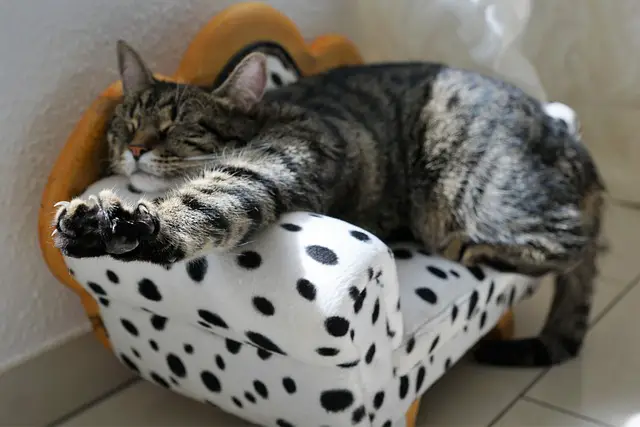Have you ever been petting your cat, only to notice that they have started opening and closing their paws? If so, you may be wondering why this is happening. Rest assured; there’s nothing wrong with your feline friend—this behavior is quite normal. But what does it mean? Let’s dive into the reasons why cats open and close their paws when they’re being petted.
Why does my cat open and close his paws when I pet him?
Cats often open and shut their paws when they enjoy affection from their owners or other people.
This behavior is thought to be cats’ attempt to indicate that they want more petting, a kind of reinforcement for the positive stimulus they are currently receiving.
An animal’s comfort level can also influence this behavior, as cats with higher levels of contentment may open and close their paws to show appreciation for being caressed.
In some cases, this phenomenon may be due to reflex rather than actual enjoyment, just a feline’s natural reaction to receiving attention.
Ultimately, it’s safe to say that your kitty opening and closing his paws while you are petting him is likely a sign of pleasure and appreciation.
The Science Behind It
When cats open and close their paws while being petted, they usually knead.
Kneading is a behavior that cats engage in to show contentment and comfort.
It typically begins when a cat is still a kitten—kittens knead on their mother’s stomachs to stimulate milk production for nursing.
As adult cats mature, the behavior continues as an expression of pleasure and relaxation.
Cats knead for several reasons.
- First, it helps them mark their territory by transferring scent from glands between the pads of their feet onto whatever surface they are kneading on (in this case, your lap). This is why some cats might knead more vigorously when you introduce them to new surroundings—they’re trying to make themselves home.
- Secondly, as mentioned previously, it helps them relax and feel comfortable in their environment.
- Thirdly, some experts believe that cats knead out of instinctive memory—they revert to the behavior they engaged in as kittens to relieve stress or anxiety.
What Does it Mean for You?
It’s always lovely when your cat shows you affection in any form.
Remember that cats often knead on blankets or soft surfaces before they curl up for a nap; if your cat starts kneading while petting them, chances are they feel safe enough with you to express contentment.
So enjoy these special moments together; just be sure not to let his sharp claws dig too deep into your skin.
Do all cats do kneading?
Though not scientifically proven, it appears true that all cats do some version of kneading.
Kneading is when cats press their front paws against a soft surface and push back and forth.
This behavior is believed to be rooted in early kittenhood when the mother cat would knead her breasts before nursing her kittens; cats may also knead out of pleasure or comfort.
There are various theories about why cats display this behavior once they reach adulthood. However, humans have long made guesses about their furry companions’ motives.
Some believe that cats knead as an expression of contentment or happiness, while others think it’s a way to mark their territory with their scent glands through the pressure of their paw pads. Whatever the reason, one thing is sure: all cats can enjoy the simple comfort of kneading.
What are other signs of contentment in cats?
While related to general happiness, contentment in cats can be challenging to measure.
Signs of contentment include purring, kneading, and head butting for physical contact.
Another sign is relaxed muscles; the cat may lay in a sprawl or appear boneless as he relaxes on his back. Finally, if a cat who typically hides from strangers starts approaching them with normal reactions, such as subtle rolling and rubbing, it can signify budding trust and contentment between them.
Additionally, cats tend to curl up and sleep soundly when they’re happy in their environment and may groom or often wash when feeling satisfied.
Paying attention to these behavior patterns can help us provide better living environments for our furry friends and ensure they are content throughout their lives.
Conclusion
So if you’ve been noticing your cat opening and closing his paws while being petted, don’t worry—it simply means he feels safe with you. Kneading can also occur when your cat is anxious or stressed; this should subside once he relaxes. So enjoy these moments together—and don’t forget about those claws! With proper training and lots of love from both sides, your bond will continue to grow stronger.
[su_box title=”Affiliate Disclosure”]This website is supported by its readers. Please assume that all links are affiliate links. If you make a purchase from one of the links we will make a commission from Amazon. Thank you.[/su_box]




